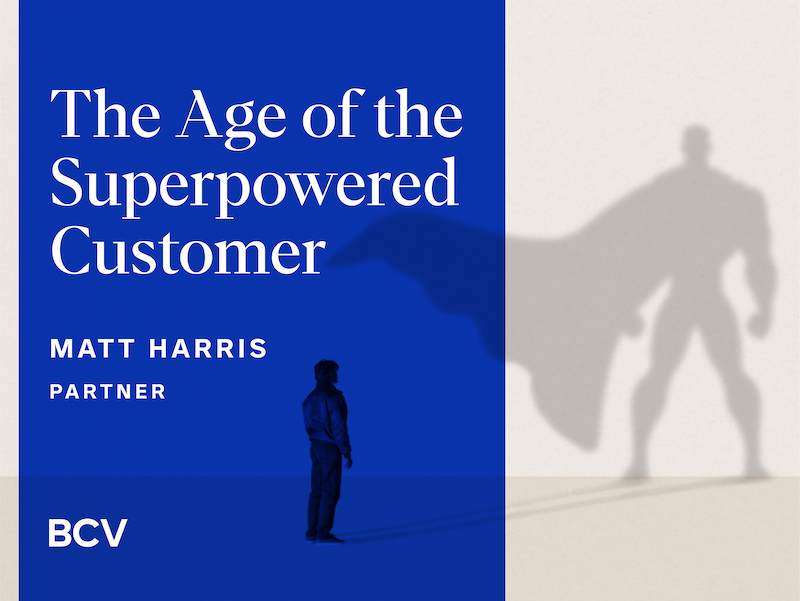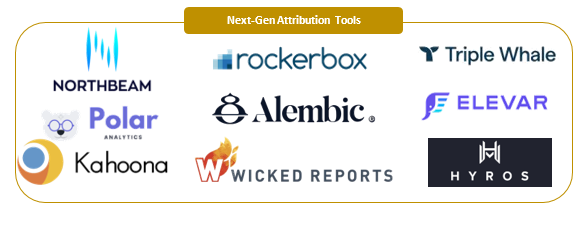
The Age of the Superpowered Customer
Generative AI can make companies more efficient, but customers have more to gain from it than they do — including in banking, commerce and medicine.

Combating first-party data changes and the future of marketing attribution
In Part I, I gave a quick overview on the current state of play for marketers based on recent privacy changes, and how we ended up here. While historical context is important, the crux of the discussion is what is next for marketers, and which start ups will help usher in the new era of attribution.
In a cookie-less world, merchants are preparing themselves to see a reduction in conversion for much of their retargeting ads and campaigns. The size of a retargeting audience will likely shrink, and the campaigns based on lookalike audiences will also suffer. Moreover, these updates are creating significant gaps in a marketer’s ability to measure the effectiveness of their advertising campaigns. Measuring attribution — the instance responsible for leading a consumer to convert — is incredibly difficult without opt-in from users. So how will marketers target and measure campaigns in the future?
Merchants, the agencies that purchase ads on their behalf, and a handful of third-party applications are coming up with innovative ways to access first-party consumer information in the absence of Apple and Google, and hyper-personalize campaigns that should theoretically improve customer acquisition costs.
First-party data may be the saving grace for brands in a post-third-party cookie and tracking world. Through discount codes, gifting, group shopping, surveys, and other wedges, merchants are activating a host of access to consumer information that would otherwise be quite difficult to obtain without purchase data. With this first-party data, customer data platforms (CDPs) like our portfolio company mParticle make it easy for brands to collect customer data and create a unified customer profile that can then be shared across the marketing tech stack — providing marketing teams with actionable insights on their customer data to segment audiences, target lookalikes, and focus spend on owned channels like email and SMS marketing (use Attentive! cough, cough) to nurture existing customer relationships, drive repeat spend, and upsell.
However, this does not solve the broader issue of addressability and tracking for merchants since prospecting (finding new customers) is growing increasingly difficult. Google tried to solve the issue by launching Federated Learning of Cohorts (FLoC) to replace cookies by grouping users with compatible interests…but that program has already died and has been replaced by Google’s Topics API, which aims to track consumer browsing history for up to three weeks. But Google’s tracker is just information on customers in their closed-loop ecosystem and not expansive across all channels. Plus, to reiterate the point, brands are spending more and more time diversifying marketing spend across multiple channels and Google and Facebook cannot be the “end all be all” for many marketers — so tracking the customer journey across multiple platforms is no easy feat.
Over the last decade, many point solutions have been built to help marketers better understand the customer journey and more effectively reallocate spend to where customers are converting. Historically, these tools have been “directionally correct” rather than the source of truth for many organizations.
Multi-touch attribution (MTA), the process of setting rules that determine how much each touchpoint along the customer journey contributes to a sale, is one way. The issue with MTA, however, is the inability to track every person’s every impression and click. People may argue collecting lots of data across touchpoints is better than none, but either way it will cause marketers to over-value certain channels and improperly spend marketing dollars. Also, MTA only tracks clicks! — so offline touchpoints, impressions and other social attributes are completely left out of model. And you probably guessed it, but the death of cookies means MTA will only become less accurate.
Marketing Mix Modeling (MMM), which uses multi-linear regression to help quantify the impact of several marketing inputs on sales, is another solution…or should I say tool rather than solution. The pitfalls of MMM comes from the complexity of metrics needed by marketers to accurately measure channel-level return on investment (ROI). It requires person-level, behavior data and proper marketing attribution on individual media effectiveness…two things that are increasingly hard to come by. And relies on the syndicated data providers (Nielsen, IRI, Kantar, Gartner) to provide the engine to analyze the data. So while MMM is good for an overview of market trends and media consumption, its long data collection timeframe and inability to provide specific insights for personalized marketing make it hard for marketers to solely rely on MMM for campaign optimization.
So what’s next? Marketers need next-generation attribution tools that are better than the free version of Google Analytics and ideally just as powerful as Google Analytics Premium, but at a fraction of the cost.
The next generation of tools are not for everyone. To see value as a DTC merchant you really need to buy in, spend a decent amount of advertising dollars, and let the campaigns run their course to truly understand what channels are working, and where efficiencies and increased ROAS can take place. It’d be great to see additional profit dollars overnight, but it rarely works like that. Typically, merchants best suited for value from attribution tools have greater than $1mm in GMV (arbitrary number, don’t quote me) where they have enough meaningful data to scale when putting marketing dollars to work and optimizing campaigns across channels. Right now, merchants find data in disparate places (Facebook, Google Analytics, etc.) but a single source of truth that operators and marketers can review multiple times a day to track performance is the goal, and what many next-generation attribution tools (as listed below in Figure 2) are striving for.

At a high level, many of the solutions listed here are tackling a similar problem from different angles. Each do the heavy upfront work to update all UTM codes (snippets of code attached to the end of a URL) and the scripts in marketing campaigns to help track the customer journey. The promise to the merchant is an algorithm (sometimes with natural language processing, or NLP) that can digest the data, cleanse it, and make it usable in a way where the end-user spends less time worrying about the flow of data and more time analyzing it to make better decisions on campaign optimization.
Unsurprisingly, merchants will want different capabilities out of a product and will also take the same data served up from a tool to make different spending decisions. But overall, after talking to a ton of merchants, the general criteria for what I think people should expect out of the new attribution tools is as follows:
1. Reach and Coverage: The best tools have out-of-the-gate integrations with all the platforms — Google, Facebook, Instagram, YouTube, Snapchat, Shopify, live shopping platforms, etc.). Ideally, they can also track unpaid impressions and partially track OTT and OOH ads. The broader the coverage, the easier to attribute sales to the proper channel and ingest multiple data points across platforms.
2. Compliant With Privacy Regulation: Ensure proper consumer data privacy controls and make it clear to the customer how security and data issues are dealt with in any scenario.
3. Accuracy: Historically, multi-touch attribution tools did not accurately weigh value to the correct channel. Having a strong data management tool with breadth of coverage that properly reports ROAS will improve the effectiveness of a marketing organization.
4. Scale: Deepest levels of granularity while being able to manage the scale of both a sophisticated website, and a website that sees a ton of volume (typically mid-market and enterprise-scale merchants).
5. Real-Time Insights: Digesting, cleaning, presenting, and refreshing data in real-time to review immediately provides merchants tremendous efficiency. If a tool integrates into the existing tech stack, teams can more efficiently use insights to drive actions/changes in the marketing ecosystem.
6. Visibility: The models an attribution tool builds are intricate and complex, and in some instances a black box. For a merchant, strong visibility, control, and access to the algorithms are important. In case merchants want to gut check and triangulate the accuracy of an application’s model (like when Facebook underreports ROAS), then being able to run your own analysis helps.
7. P&L Visibility: Overall, using a tool that combines a view of the P&L (so the whole team works under one per view) is paramount. In a well-oiled organization, the P&L influences when and how the marketing organization spends to, at a bare minimum, break even on total gross-margin adjusted acquisition spend. The north star is using real-time insights for dynamic resource allocation — to understand how to forecast growth through a combination of growth opportunities and marketing spend, and properly allocate spend to channels that drive better ROAS based on available resources.
8. Recommendations: The most valuable tools are those that are “in the money”. Analytics are great, but tools that can run NLP on raw data to make suggestions and make those insights come to life drive the most value.
9. Customer Insights: On top of attribution, the data these tools collect enables them to do so much more. Tools that can also serve up customer insights on cohort data and lifetime value become the single source of truth for e-commerce operators.
10. Support: Ideally each tool is out-of-the-box and easy to use. While it seems table stakes, applications with a great user experience, savvy reports, and strong customer support are not that common.
The ecosystem of third-party providers building products that help merchants face regulatory changes to consumer privacy are growing. At BCV, we are seeing more and more B2B solutions think about this issue and incorporate varying capabilities to assist on data collection, and we are eager to back the next-gen mar-tech tools that can support most of the aforementioned criteria. Structural changes are bound to happen every handful of years, and it will be interesting to see how organizations adapt over the next 12 months to privacy changes. If you have opinions, or want to jam on this topic, or any other topics in the commerce and marketing technology arena, I’m always around.
P.S. By no means are my thoughts completely fleshed out. I welcome any constructive criticism and feedback to help me better understand what is happening in this space and what will happen.
Generative AI can make companies more efficient, but customers have more to gain from it than they do — including in banking, commerce and medicine.
Together with Bain & Company and Coresight Research, we are proud to present the inaugural CommerceTech Power List, recognizing the most innovative marketing, merchandising and loyalty related technologies.
A week and a half ago, Shopify released its Q2 Earning’s report and shares sank 14% on the day after the company announced it plans to lay off 10% of its global workforce (~1,000 employees). CEO Tobi Lutke acknowledged that he and his executive team had overestimated the long-standing success that e-commerce would have in…